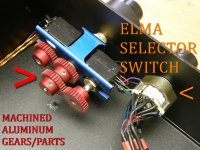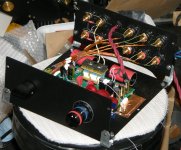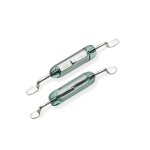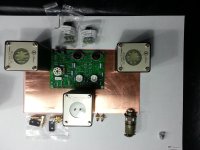I have used Alpha pots (made in Taiwan) in the past. I ordered a batch of pots for a project and have found that although they still have a nice smooth operation, their resistance tolerances leave a lot to be desired. In dual pots, the sections may or may not match. A 500K dual pot may be 500K in one section and 450K in the other. In a volume control, at lower volume levels, this causes the channel balance to shift. To get a pot with both sections the same resistance, you have to order a bunch and weed out the bad ones. The audio taper pots all seem to not really be an audio taper. They are more like linear until near the end of rotation, then suddenly the resistance changes. Mechanically they are nice pots, electronically not so much. Any suggestions for more accurate pots?
It's not only the difference between the full resistance values of the 2 section but also deviation between the tapers.
I measured a few different dual pots and found differences in output voltage of up to 35%.
By far the most accurate dual pots are made by Alps/Japan, but expensive.
I measured a few different dual pots and found differences in output voltage of up to 35%.
By far the most accurate dual pots are made by Alps/Japan, but expensive.
TKDs are normally also great (but often pricey). Otherwise stepped attenuators - either rotary ones or relay-based - usually all but eliminate the tracking errors, but again at a cost.
If precise channel balancing is desired, stepped attenuators are the best choice.
https://www.ebay.com/itm/304439894952
https://www.ebay.com/itm/304439894952
I wonder if we could DIY a better version for cheaper. The internal PCB looks very straight forward, using SMD resistors. it's only the mechanics that would be challenging, maybe a 3D print/CNC would be nice.
I'm currently in need of couple of good pots myself.

I'm currently in need of couple of good pots myself.
How is it that all these pots are listed as used? Judging from images, there seems to be no evidense of being soldered.if precise channel balancing is desired, stepped attenuators are the best choice.
https://www.ebay.com/itm/304439894952
Yes. Perhaps using a SBC so that it could be network controlled.You mean with a series of small relays?
It can get very expensive, this attenuating of the signal. Thing is, at the least I see it as a very important job to be done with as much precision as required. We are looking at 1-2 lousy volts which don't have much reason to go on. I won't go into the hundreds because that is ridiculous to me. Two variations that I would support if I have the funds are
1) GlassWare Audio's stepped attenuator, which yields 66 steps using a ladder/shunt configuration. Quality of the switches and resistors is up to you.
2) This device allows a stacked set of mono pots that gives whatever your heart desires for each channel (I chose older Noble mono pots for this).
1) GlassWare Audio's stepped attenuator, which yields 66 steps using a ladder/shunt configuration. Quality of the switches and resistors is up to you.
2) This device allows a stacked set of mono pots that gives whatever your heart desires for each channel (I chose older Noble mono pots for this).
Attachments
Call me ridiculous: I bought a pair of Goldpoint attenuators and liked them so much compared to the Alps that I bought two more pairs for two more amps.
Thinking more outside the box. How about using reed switches to do the switching, and somehow mechanically move a magnet over them?Yes. Perhaps using a SBC so that it could be network controlled.
I know there has been attempts with LDR's too, but I've found the width of resistance a problem.
Attachments
Last edited:
I have a few dozen of the Alpha Taiwan potentiometers. The total resistance of the tracks sometimes is far off, but the channel matching on some of them is within 0.5dB and 1.3dB at the worst. Being less than a dollar each, they are inexpensive enough to test and sort to find the best ones.I have used Alpha pots (made in Taiwan) in the past. I ordered a batch of pots for a project and have found that although they still have a nice smooth operation, their resistance tolerances leave a lot to be desired. In dual pots, the sections may or may not match. A 500K dual pot may be 500K in one section and 450K in the other. In a volume control, at lower volume levels, this causes the channel balance to shift. To get a pot with both sections the same resistance, you have to order a bunch and weed out the bad ones. The audio taper pots all seem to not really be an audio taper. They are more like linear until near the end of rotation, then suddenly the resistance changes. Mechanically they are nice pots, electronically not so much. Any suggestions for more accurate pots?
I had some of those custom made this year with Susumu RR thin films, modified linear taper for a different control. Like all stepped types, they benefit from adding a grounded shield around the body.I wonder if we could DIY a better version for cheaper. The internal PCB looks very straight forward, using SMD resistors. it's only the mechanics that would be challenging, maybe a 3D print/CNC would be nice.
I'm currently in need of couple of good pots myself.
View attachment 1403891
Last edited:
- Home
- Amplifiers
- Tubes / Valves
- Alpha Potentiometers



